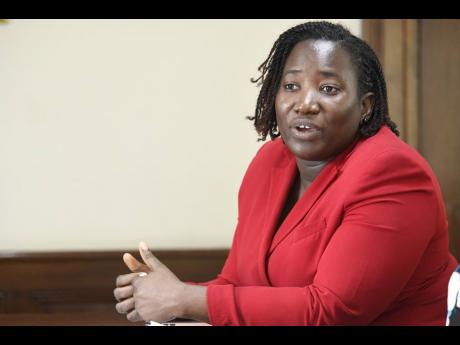HIV lessons from COVID fight
Experts, advocates call for more targeted approach to reduce transmission rate
Lamenting that the fight to end HIV/AIDS is only thrust into the spotlight once a year as the globe celebrates World AIDS Day on December 1, activist Joan Stephens is calling for an all-hands-on-deck, yearlong campaign to drive down transmission rates, similar to sustained targeted action in the COVID-19 battle.
This, she told a Gleaner Editors’ Forum, should also include a robust public education campaign and provide the requisite funding to drive behavioural change, similarly to how Jamaicans from all walks of life and sectors have stepped up to tackle COVID-19.
“It’s an ongoing situation, just like with COVID,” Stephens, who is also HIV-positive, told the forum. “It is here, so how do we deal with it is the important thing. So, just as how we emphasising and going from community to get everybody vaccinated against COVID, we need everybody to put that emphasis on HIV just the same. That’s the only way we’re gonna reach where we need to reach ... .”
A community facilitator for the Jamaican Network of Seropositives (JN+), a national body advocating for the rights and concerns of people living with and affected by HIV, Stephens added: “There is so much more that we can do as a society.”
Noting other changes wrought by the COVID-19 pandemic, including restrictions on face-to-face gatherings, fellow panellist Kandasi Levermore, executive director of Jamaica AIDS Support for Life (JASL), said that her team has been forced to be more strategic in its response, with a better understanding of the need for flexibility in its operations.
“The bureaucracies have had to be removed in a lot of instances and I think that it’s a win for the people of Jamaica in terms of how it has shown us – not just in health, but in all over – that some of these red tapes needed to go,” she said.
“For the clients, it was good in that a number of persons, seeing an additional health risk factor, took their HIV status into consideration and so a number of persons who we considered lost to follow-up are coming back into care because they wanted to ensure that they had the strongest immune system, should they contract COVID,” she explained.
She added that COVID-19 has also opened people’s eyes to be more compassionate and empathetic as communities have stepped up to help each other.
“That was one of the most beautiful things to see in COVID and ... we hope it will be kept up post-COVID,” she said.
Strong political leadership which directs high level action is crucial, noted UNAIDS Country Director Manoela Manova, who also witnessed a number of downsides to the pandemic, especially the restrictions on movement and gatherings, which disrupted some service delivery, including condom distributions, and delays in getting HIV viral load results from labs under pressure to do COVID-19 testing.
With the COVID-19-induced lockdowns, there has also been an increase in home visits to do HIV testing, noted Dr Aisha Robb, senior director of the HIV/STI Unit in the Ministry of Health and Wellness.
“We recognised that there are other services that we were capable of offering on a larger scale now that we had more resources in some settings, because we then had more funding from some of our funders, so that we could expand services in some of our people living with HIV needs. It also showed us that, as a health system, we had to be adaptable and I think that, as a health system, we have adapted,” she said.
Just over $600 million has been budgeted this year for antiretroviral therapy for some 16,000 patients, although there is space to accommodate new persons to begin treatment.
“We forecast for an average of 2,500 persons being added on an annual basis, whether new cases or people coming back to care. So that budget is allocated for about 18,000 persons on an annual basis.”

